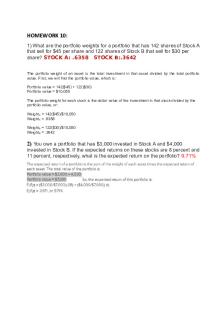Homework 11 PDF

| Title | Homework 11 |
|---|---|
| Course | Calculus II |
| Institution | New York University |
| Pages | 2 |
| File Size | 91.8 KB |
| File Type | |
| Total Downloads | 68 |
| Total Views | 140 |
Summary
Spring 2016 Calculus 2 Homework #11 Professor Songjaja...
Description
Calculus 2 (Math-UA-122)
Spring 2016
Homework 11 Due: Wednesday, May 4 at the start of class Give complete, well-written solutions to the following exercises. 1. Find the Taylor series centered at the given value of a and find the associated radius of convergence. 1 (a) f (x) = , a = 1 x (b) f (x) = (x2 + 2x)ex , a = 0 2. Find the terms through degree four of the Maclaurin series for f (x). (a) f (x) = ex ln(1 − x).
Hint: First find the Maclaurin Series for ex and for ln(1 − x). Then, write the first few terms of each power series. Multiply them to get the power series of the product.
(b) f (x) =
sin(x) . 1−x
1 Hint: First find the Maclaurin Series for sin(x) and for 1−x . Then, write the first few terms of each power series. Multiply them to get the power series of the product.
3. Consider the parametric curve given by x=
t t−2 , , y= t+1 t−1
− 1 < t < 1.
(a) Sketch the curve by using the parametric equation to plot points. Indicate with an arrow the direction in which the curve is traced as t increases. (b) Find a Cartesian equation of the curve (i.e., an equation in terms of x and y that describes the curve) 4. Compare the curves represented by the three parametric equations below. State how they differ or how they are similar to one another. (a) x = t, y = t−2 (b) x = et , y = e−2t (c) x = cos(t), y = sec2 (t)
[Problems 5-8 are on the next page] 1
Calculus 2 (Math-UA-122)
Spring 2016
5. Find a parametrization for the circle (x − 2)2 + y 2 = 1 starting at the point (1, 0) and moving clockwise twice around the circle, using the central angle θ in the figure below as a parameter.
6. The curve with parametric equations x = (1 + 2 sin(θ) cos(θ), y = (1 + 2 sin(θ)) sin(θ ) is called a lima¸con and is shown in the figure below.
(a) Find the point (x, y) that corresponds to θ = π/2. (b) Find the slope of the line that is tangent to the graph at θ = π/2. (c) Find the slope of the line that is tangent to the graph at (x, y) = (1, 0). 7. Find the area enclosed by the curve x = 1 + et and y = 1 − t2 and the x-axis. 8. Sketch the curves below and find the length of the curve. (a) x = cos(2t), y = sin(2t), 0 ≤ t ≤ π/2.
(b) x = sin(πt), y = cos(πt), −0.5 ≤ t ≤ 0.5. √ (c) x = t, y = 1 − t2 , −1 ≤ t ≤ 1. [Note: This problem illustrates the fact that the length of a curve does not depend on the way we parametrize the curve.]
2...
Similar Free PDFs

Homework 11
- 2 Pages

Homework 11
- 2 Pages

Homework 11
- 11 Pages

Homework Solution 11
- 4 Pages

Hw 11-5 - Homework
- 2 Pages

HW11 - Homework 11
- 2 Pages

Homework 11 nbhgv
- 6 Pages

HW11 - Homework 11
- 2 Pages

Stock Homework Chp 11
- 6 Pages

3-2 Homework - Chapter 11
- 20 Pages
Popular Institutions
- Tinajero National High School - Annex
- Politeknik Caltex Riau
- Yokohama City University
- SGT University
- University of Al-Qadisiyah
- Divine Word College of Vigan
- Techniek College Rotterdam
- Universidade de Santiago
- Universiti Teknologi MARA Cawangan Johor Kampus Pasir Gudang
- Poltekkes Kemenkes Yogyakarta
- Baguio City National High School
- Colegio san marcos
- preparatoria uno
- Centro de Bachillerato Tecnológico Industrial y de Servicios No. 107
- Dalian Maritime University
- Quang Trung Secondary School
- Colegio Tecnológico en Informática
- Corporación Regional de Educación Superior
- Grupo CEDVA
- Dar Al Uloom University
- Centro de Estudios Preuniversitarios de la Universidad Nacional de Ingeniería
- 上智大学
- Aakash International School, Nuna Majara
- San Felipe Neri Catholic School
- Kang Chiao International School - New Taipei City
- Misamis Occidental National High School
- Institución Educativa Escuela Normal Juan Ladrilleros
- Kolehiyo ng Pantukan
- Batanes State College
- Instituto Continental
- Sekolah Menengah Kejuruan Kesehatan Kaltara (Tarakan)
- Colegio de La Inmaculada Concepcion - Cebu





